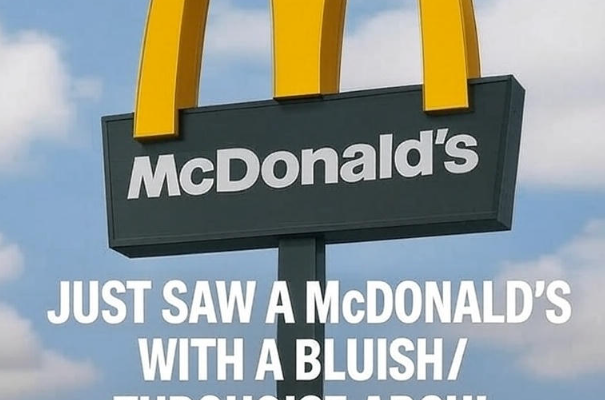
Why One McDonald’s Has Turquoise Arches — The Story Behind the Most Unusual Golden Arches in America
Across the globe, the glowing golden arches of McDonald’s are one of the most recognizable symbols in modern culture. But in one small corner of the American Southwest, something completely different—and surprisingly beautiful—stands out. Instead of the familiar yellow, one McDonald’s proudly features turquoise arches, a striking departure from the brand’s iconic design. For years, travelers have pulled over, snapped photos, and asked the same question:
Why would McDonald’s change its famous golden arches to turquoise?
The answer lies in a blend of local heritage, architectural regulations, and a city that takes great pride in preserving its traditional aesthetic. And along the way, this unusual McDonald’s has become a symbol of how global brands adapt to the communities they serve.
A City With a Unique Vision
To understand this one-of-a-kind McDonald’s, we have to look at where it stands: Sedona, Arizona. Known for its breathtaking red rock landscapes, dramatic desert cliffs, and spiritual retreats, Sedona is a place unlike any other in the United States. The city has long been committed to maintaining the natural beauty and cultural feel of the region. That dedication extends not just to homes and landmarks, but even to commercial businesses.
In the late 1980s and early 1990s, as Sedona grew in popularity, more national chains wanted to open locations in the city. But Sedona residents and officials were clear: Nothing should clash with the natural environment. No bright neon signs. No loud or intrusive architecture. No colors that would interrupt the harmony of the desert.
When McDonald’s applied to build a restaurant in Sedona, they ran into a unique problem:
the city had strict zoning laws that banned bright colors—especially the bold yellow McDonald’s is known for. Officials argued that the shining golden arches would stand out too harshly against the red rocks, disrupting the area’s natural visual flow.
A Compromise in Color
McDonald’s, wanting to respect the community’s wishes while still maintaining its brand identity, searched for a compromise. After discussions with local leaders and designers, a decision was made:
The arches would remain the same design—but they would be painted turquoise instead of yellow.
Why turquoise? The color blended beautifully with the local buildings, many of which feature earthy adobe tones accented with shades of blue and green inspired by Native American art. Turquoise also holds cultural significance in the Southwest, symbolizing protection, strength, and harmony.
The result was a McDonald’s location unlike any other in the world. Instead of the shining gold, visitors are greeted by serene, soft turquoise arches that echo the tones of desert sky and local art traditions.
A Restaurant That Became a Landmark
Ironically, the decision to tone down the arches had the opposite effect—this McDonald’s quickly became one of the most photographed and talked-about locations in the country. Tourists flock to Sedona not only for its natural wonders but also to see the “famous turquoise McDonald’s.” People take photos beneath the arches, buy souvenirs, and share snapshots with family and friends.
What was meant to blend in has, in a way, become even more iconic.
Visitors often say that this McDonald’s feels more connected to the community than a typical fast-food chain. With its muted tones, Southwestern-style architecture, and desert-friendly design, it stands as an example of how large corporations can adapt in meaningful ways when they truly listen to local culture.
Color With a Deeper Meaning
But the story goes beyond zoning laws and architectural aesthetics. Turquoise has deep spiritual and cultural meaning in the Southwest, particularly among Native American tribes such as the Navajo, Hopi, and Apache.
In their traditions, turquoise symbolizes:
-
Protection
-
Healing
-
Success
-
Connection to the sky and water
-
Harmony and balance
Whether intentional or not, McDonald’s turquoise arches echo this symbolism. Many visitors feel that the color adds a sense of calm and beauty to a space that is normally associated with fast-paced modern life.
Preservation Over Corporate Branding
Cities like Sedona are rare in that they push back against uniform commercial architecture. Rather than allowing chains to impose their global designs on local landscapes, Sedona insists on the opposite: businesses must respect the city’s visual identity.
This isn’t limited to McDonald’s. Other chains, too, have had to adjust—Starbucks has toned down colors and signage, gas stations have modified their lighting, and even grocery stores use muted desert-inspired palettes.
The turquoise arches are a reminder that preservation matters, and that communities can take ownership of their appearance even in a world dominated by nationwide brands.
A Symbol of Local Identity
Over time, the turquoise arches have become more than a curious tourist attraction—they’ve become a symbol of Sedona’s commitment to authenticity. Residents take pride in this small victory of preservation. It represents a community choosing to keep its unique charm rather than conform to a one-size-fits-all commercial world.
Travelers often share how refreshing it is to see a McDonald’s that doesn’t look like the rest. In an age where uniformity defines most fast-food chains, this location stands out as a beautiful example of cultural individuality.
An Icon With a Story
The turquoise McDonald’s challenges our assumptions about branding and architecture. It shows that even the world’s most consistent brand can—and sometimes must—bend to respect local values. Instead of clashing with Sedona’s natural beauty, the restaurant blends into it, becoming part of the landscape rather than interrupting it.
Today, the turquoise arches are more than just a design choice. They’re a reminder that beauty, heritage, and identity can exist even in the most unexpected places.
So if you ever find yourself driving through Sedona, keep an eye out for the soft blue glow. You won’t just be seeing a fast-food sign—you’ll be seeing a story etched into color, culture, and community.

